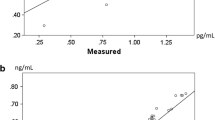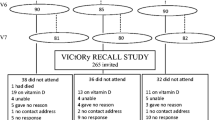Abstract
Summary
Determination of different forms of 25-OHD (total, free and bioavailable) in healthy young women does not offer additional advantages over standard 25-OHDT for evaluating vitamin D deficiency. In these subjects 25-OHDT values <15 ng/ml would be more appropriate for defining this deficiency.
Introduction
Determination of 25-OH vitamin D serum levels (25-OHD) constitutes the method of choice for evaluating vitamin D deficiency. However, vitamin D-binding protein (DBP) may modulate its bioavailability thereby affecting correct evaluation of 25-OHD status. We analysed the impact of the determination of 25-OHD (total, free and bioavailable) on the evaluation its biologic activity (estimated by serum PTH determination) in healthy young women.
Methods
173 premenopausal women (aged 35–45 yrs.) were included. We analysed serum values of total 25-OHD (25-OHDT), DBP, albumin, PTH and bone formation (PINP,OC) and resorption (NTx,CTx) markers. Free(25-OHDF) and bioavailable (25-OHDB) serum 25-OHD levels were estimated by DBP and albumin determinations and also directly by ELISA (25-OHDF-2). We analysed threshold PTH values for the different forms of 25-OHD and the correlations and differences according to 25-OHDT levels <20 ng/ml.
Results
62% of subjects had 25-OHD values <20 ng/ml and also had significantly lower 25-OHDF and 25-OHDB values, with no significant differences in bone markers and PTH values. The PTH threshold value was similar for all forms of 25-OHD (∼70 pg/ml). Women with PTH values >70 had lower 25-OHDT (15.4 ± 1.4 vs. 18.3 ± 2.7, p < 0.05) and 25OHDB values (1.7 ± 0.2 vs. 2.2 ± 0.09, p < 0.05). The different forms of 25OHD were significantly intercorrelated, with marginal correlations between PTH and 25-OHDT (r = −0.136, p = 0.082).
Conclusions
Determination of different forms of 25-OHD in healthy young women does not offer additional advantages over standard 25-OHDT for evaluating vitamin D deficiency. In these subjects 25-OHDT values <15 ng/ml would be more appropriate for defining this deficiency.


Similar content being viewed by others
Abbreviations
- BMI:
-
Body mass index
- 25-OHDT :
-
Total 25 OH vitamin D
- PTH:
-
Parathyroid hormone
- DBP:
-
Vitamin D-binding protein
- 25-OHDF :
-
Free 25-OH vitamin D
- 25-OHDB :
-
Bioavailable 25-OH vitamin D
- 25-OHDF-2 :
-
Free 25-OH vitamin D by ELISA
- Bone ALP:
-
Bone alkaline phosphatase
- PINP:
-
Total serum procollagen type I amino-terminal propeptide
- OC:
-
Osteocalcin
- NTx:
-
Urinary cross-linked N-terminal telopeptide of type I collagen
- CTx:
-
Serum cross-linked C-terminal telopeptide of type I collagen
References
Lips P, Hosking D, Lippuner K, Norquist JM, Wehren L, Maalouf G et al (2006) The prevalence of vitamin D inadequacy amongst women with osteoporosis: an international epidemiological investigation. J Intern Med 260:245–254
Spiro A, Buttriss JL (2014) Vitamin D: an overview of vitamin D status and intake in Europe. Nutr Bull 39:322–350
Fuleihan G-H, Bouillon R, Clarke B, Chakhtoura M, Cooper C, McClung M et al (2015) Serum 25-Hydroxyvitamin D levels: variability, knowledge gaps, and the concept of a desirable range. J Bone Miner Res 30:1119–1133
Holick MF, Siris ES, Binkley N, Beard MK, Khan A, Katzer JT et al (2005) Prevalence of vitamin D inadequacy among postmenopausal north American women receiving osteoporosis therapy. J Clin Endocrinol Metab 90:3215–3224
Harris SS, Soteriades E, Dawson-Hughes B (2001) Secondary hyperparathyroidism and bone turnover in elderly blacks and whites. J Clin Endocrinol Metab 86:3801–3804
Powe CE, Ricciardi C, Berg AH, Erdenesanaa D, Collerone G, Ankers E et al (2011) Vitamin D-binding protein modifies the vitamin D-bone mineral density relationship. J Bone Miner Res 26:1609–1616
Powe CE, Evans MK, Wenger J, Zonderman AB, Berg AH, Nalls M et al (2013) Vitamin D-binding protein and vitamin D status of black Americans and white Americans. N Engl J Med 369:1991–2000
Bikle D, Bouillon R, Thadhani R, Schoenmakers I (2017) Vitamin D metabolites in captivity? Should we measure free or total 25(OH)D to assess vitamin D status?. J Steroid Biochem Mol Biol. (in press)
Holick MF (2013) Bioavailability of vitamin D and its metabolites in black and white adults. N Engl J Med 369:2047–2048
Guañabens N, Filella X, Monegal A, Gómez-Vaquero C, Bonet M, Buquet D et al (2016) Reference intervals for bone turnover markers in Spanish premenopausal women. Clin Chem Lab Med 54:293–303
Dawson-Hughes BN, Heaney RP, Holick MF, Lips P, Meunier PJ, Vieth R (2005) Estimates of optimal vitamin D status. Osteoporos Int 16:713–716
Muggeo VMR (2003) Estimating regression models with unknown break-points. Stat Med 22:3055–3071
R Core Team. R: A language and environment for statistical computing. R. Foundation for Statistical Computing, Vienna, Austria. 2016. URL https://www.R-project.org/.
Ponda MP, McGee D, Breslow JL (2014) Vitamin D-binding protein levels do not influence the effect of vitamin D repletion on serum PTH and calcium: data from a randomized, controlled trial. J Clin Endocrinol Metab 99:2494–2499
Dastani Z, Berger C, Langsetmo L, Fu L, Wong BY, Malik S et al (2014) In healthy adults, biological activity of vitamin D, as assessed by serum PTH, is largely independent of DBP concentrations. J Bone Miner Res 29:494–499
Schwartz JB, Lai J, Lizaola B, Kane L, Markova S, Weyland P et al (2014) A comparison of measured and calculated free 25(OH) vitamin D levels in clinical populations. J Clin Endocrinol Metab 99:1631–1637
Denburg MR, Hoofnagle AN, Sayed S, Gupta J, de Boer IH, Appel LJ et al (2016) Chronic renal insufficiency cohort study investigators. Comparison of two ELISA methods and mass spectrometry for measurement of vitamin D-binding protein: implications for the assessment of bioavailable vitamin D concentrations across genotypes. J Bone Miner Res 31:1128–1136
Abrams SA, Griffin IJ, Hawthorne KM, Gunn SK, Gundberg CM, Carpenter TO (2005) Relationships among vitamin D levels, parathyroid hormone, and calcium absorption in young adolescents J Clin Endocrinol Metab 90:5576–5581
Saadi HF, Nagelkerke N, Benedict S, Qazaq HS, Zilahi E, Mohamadiyeh MK et al (2006) Predictors and relationships of serum 25 hydroxyvitamin D concentration with bone turnover markers, bone mineral density, and vitamin D receptor genotype in Emirati women. Bone 39:1136–1143
Larijani B, Hossein-Nezhad A, Feizabad E, Maghbooli Z, Adibi H, Ramezani M et al (2016) Vitamin D deficiency, bone turnover markers and causative factors among adolescents: a cross-sectional study. J Diabetes Metab Disord 15:46
Li M, Lv F, Zhang Z, Deng W, Li Y, Deng Z et al (2016) Establishment of a normal reference value of parathyroid hormone in a large healthy Chinese population and evaluation of its relation to bone turnover and bone mineral density. Osteoporos Int 27:1907–1916
Sahota O, Mundey MK, San P, Godber IM, Lawson N, Hosking DJ (2004) The relationship between vitamin D and parathyroid hormone: calcium homeostasis, bone turnover, and bone mineral density in postmenopausal women with established osteoporosis. Bone 35:312–319
Sai AJ, Walters RW, Fang X, Gallagher JC (2011) Relationship between vitamin D, parathyroid hormone, and bone health. J Clin Endocrinol Metab 96:E436–E446
Valcour A, Blocki F, Hawkins DM, Rao SD (2012) Effects of age and serum 25-OH-vitamin D on serum parathyroid hormone levels. J Clin Endocrinol Metab 97:3989–3995
Chapuy MC, Menier PP (1997) Vitamin D insufficiency in adults and the elderly. In: Feldman D (ed) Vitamin D. Academic Press, San Diego, pp p679–p693
Tangpricha V, Pearce EN, Chen TC, Holick MF (2002) Vitamin D insufficiency among free-living healthy young adults. Am J Med 112:659–662
Lamberg-Allardt CJ, Outila TA, Kärkkainen MU, Rita HJ, Valsta LM (2001) Vitamin D deficiency and bone health in healthy adults in Finland: could this be a concern in other parts of Europe? J Bone Miner Res 16:2066–2073
LeBlanc ES, Zakher B, Daeges M, Pappas M, Chou R (2015) Screening for vitamin D deficiency: a systematic review for the U.S. preventive services task force. Ann Intern Med 162:109–122
Acknowledgements
This work was supported in part by a grant from Societat Catalana de Reumatología.
LabOscat study group
Marta Larrosa, Rheumatology Department, University Institute Parc Taulí, Sabadell; Joan Miquel Nolla, Rheumatologý Department, IDIBELL, Hospital Universitari de Bellvitge, L’Hospitalet, Barcelona; Daniel Roig-Vilaseca, Rheumatology Department, Hospital Moisés Broggi, Barcelona.
Author information
Authors and Affiliations
Consortia
Corresponding authors
Ethics declarations
Conflicts of interest
Pilar Peris, Xavier Filella, Ana Monegal, Nuria Guañabens, Laura Foj, María Bonet, Dolors Boquet, Enrique Casado, Dacia Cerdá, Alba Erra, Carmen Gómez-Vaquero, Silvia Martínez, Nuria Montalá, Concepción Pittarch, Eduardo Kanterewicz, Miquel Sala, Xavier Suris and Josep L Carrasco declare that they have no conflict of interest.
Rights and permissions
About this article
Cite this article
Peris, P., Filella, X., Monegal, A. et al. Comparison of total, free and bioavailable 25-OH vitamin D determinations to evaluate its biological activity in healthy adults: the LabOscat study. Osteoporos Int 28, 2457–2464 (2017). https://doi.org/10.1007/s00198-017-4062-8
Received:
Accepted:
Published:
Issue Date:
DOI: https://doi.org/10.1007/s00198-017-4062-8




